Motion User Guide
- Welcome
- What’s new
-
- Intro to basic compositing
-
- Intro to transforming layers
-
- Intro to transforming layers in the canvas
- Transform layer properties in the canvas
- Transform tools
- Change layer position, scale, or rotation
- Move a layer’s anchor point
- Add a drop shadow to a layer
- Distort or shear a layer
- Crop a layer
- Modify shape or mask points
- Transform text glyphs and other object attributes
- Align layers in the canvas
- Transform layers in the HUD
- Transform 2D layers in 3D space
-
- Intro to behaviors
- Behaviors versus keyframes
-
- Intro to behavior types
-
- Intro to Parameter behaviors
- Audio behavior
- Average behavior
- Clamp behavior
- Custom behavior
- Add a Custom behavior
- Exponential behavior
- Link behavior
- Logarithmic behavior
- MIDI behavior
- Add a MIDI behavior
- Negate behavior
- Oscillate behavior
- Create a decaying oscillation
- Overshoot behavior
- Quantize behavior
- Ramp behavior
- Randomize behavior
- Rate behavior
- Reverse behavior
- Stop behavior
- Track behavior
- Wriggle behavior
-
- Intro to Simulation behaviors
- Align to Motion behavior
- Attracted To behavior
- Attractor behavior
- Drag behavior
- Drift Attracted To behavior
- Drift Attractor behavior
- Edge Collision behavior
- Gravity behavior
- Orbit Around behavior
- Random Motion behavior
- Repel behavior
- Repel From behavior
- Rotational Drag behavior
- Spring behavior
- Vortex behavior
- Wind behavior
- Additional behaviors
-
- Intro to using generators
- Add a generator
-
- Intro to image generators
- Caustics generator
- Cellular generator
- Checkerboard generator
- Clouds generator
- Color Solid generator
- Concentric Polka Dots generator
- Concentric Shapes generator
- Gradient generator
- Grid generator
- Japanese Pattern generator
- Lens Flare generator
- Manga Lines generator
- Membrane generator
- Noise generator
- One Color Ray generator
- Op Art 1 generator
- Op Art 2 generator
- Op Art 3 generator
- Overlapping Circles generator
- Radial Bars generator
- Soft Gradient generator
- Spirals generator
- Spiral Drawing generator
- Use Spiral Drawing onscreen controls
- Star generator
- Stripes generator
- Sunburst generator
- Truchet Tiles generator
- Two Color Ray generator
- Save a custom generator
-
- Intro to filters
- Browse and preview filters
- Apply or remove filters
-
- Intro to filter types
-
- Intro to Color filters
- Brightness filter
- Channel Mixer filter
- Color Adjustments filter
- Color Balance filter
- Example: Color-balance two layers
- Color Curves filter
- Use the Color Curves filter
- Color Reduce filter
- Color Wheels filter
- Use the Color Wheels filter
- Colorize filter
- Contrast filter
- Custom LUT filter
- Use the Custom LUT filter
- Gamma filter
- Gradient Colorize filter
- HDR Tools filter
- Hue/Saturation filter
- Hue/Saturation Curves filter
- Use the Hue/Saturation Curves filter
- Levels filter
- Negative filter
- OpenEXR Tone Map filter
- Sepia filter
- Threshold filter
- Tint filter
-
- Intro to Distortion filters
- Black Hole filter
- Bulge filter
- Bump Map filter
- Disc Warp filter
- Droplet filter
- Earthquake filter
- Fisheye filter
- Flop filter
- Fun House filter
- Glass Block filter
- Glass Distortion
- Insect Eye filter
- Mirror filter
- Page Curl filter
- Poke filter
- Polar filter
- Refraction filter
- Ring Lens filter
- Ripple filter
- Scrape filter
- Sliced Scale filter
- Use the Sliced Scale filter
- Sphere filter
- Starburst filter
- Stripes filter
- Target filter
- Tiny Planet filter
- Twirl filter
- Underwater filter
- Wave filter
-
- Intro to Stylize filters
- Add Noise filter
- Bad Film filter
- Bad TV filter
- Circle Screen filter
- Circles filter
- Color Emboss filter
- Comic filter
- Crystallize filter
- Edges filter
- Extrude filter
- Fill filter
- Halftone filter
- Hatched Screen filter
- Highpass filter
- Indent filter
- Line Art filter
- Line Screen filter
- MinMax filter
- Noise Dissolve filter
- Pixellate filter
- Posterize filter
- Relief filter
- Slit Scan filter
- Slit Tunnel filter
- Texture Screen filter
- Vignette filter
- Wavy Screen filter
- About filters and color processing
- Publish filter controls to Final Cut Pro
- Using filters on alpha channels
- Filter performance
- Save custom filters
-
- Intro to 360-degree video
- 360-degree projects
- Create 360-degree projects
- Add 360-degree video to a project
- Create a tiny planet effect
- Reorient 360-degree media
- Creating 360-degree templates for Final Cut Pro
- 360-degree-aware filters and generators
- Export and share 360-degree projects
- Guidelines for better 360-degree projects
-
- Intro to settings and shortcuts
-
- Intro to Keyboard shortcuts
- Use function keys
- General keyboard shortcuts
- Audio list keyboard shortcuts
-
- Tools keyboard shortcuts
- Transform tool keyboard shortcuts
- Select/Transform tool keyboard shortcuts
- Crop tool keyboard shortcuts
- Edit Points tool keyboard shortcuts
- Edit shape tools keyboard shortcuts
- Pan and Zoom tools keyboard shortcuts
- Shape tools keyboard shortcuts
- Bezier tool keyboard shortcuts
- B-Spline tool keyboard shortcuts
- Paint Stroke tool keyboard shortcuts
- Text tool keyboard shortcuts
- Shape mask tools keyboard shortcuts
- Bezier Mask tool keyboard shortcuts
- B-Spline Mask tool keyboard shortcuts
- Transport control keyboard shortcuts
- View option keyboard shortcuts
- HUD keyboard shortcuts
- Inspector keyboard shortcuts
- Keyframe Editor keyboard shortcuts
- Layers keyboard shortcuts
- Library keyboard shortcuts
- Media list keyboard shortcuts
- Timeline keyboard shortcuts
- Keyframing keyboard shortcuts
- Shape and Mask keyboard shortcuts
- 3D keyboard shortcuts
- Miscellaneous keyboard shortcuts
- Touch Bar shortcuts
- Move assets to another computer
- Work with GPUs
- Glossary
- Copyright and trademarks

Use the Color Wheels filter in Motion
The Color Wheels filter contains four color wheel controls (Global, Shadows, Midtones, and Highlights) to adjust color, brightness, and saturation in clips and images.
When you apply the Color Wheels filter, its settings appear in the Filters Inspector:
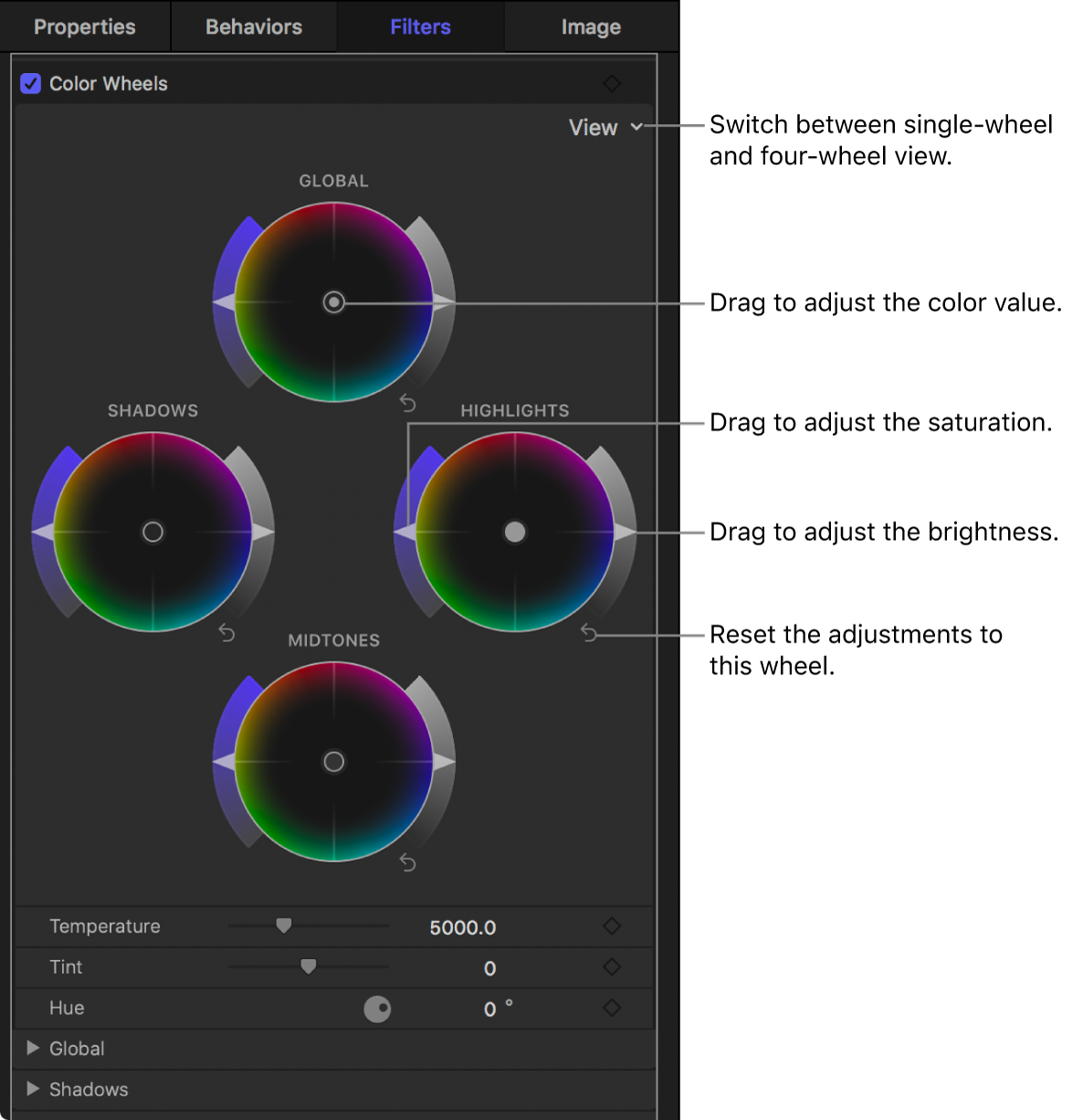
Note: Because you can apply multiple color filters to an image, you’re not required to follow all of the steps below, nor the order of those steps. For example, you might adjust the overall contrast with the Color Curves filter and adjust a color tint with the Color Wheels filter. Or you could achieve the same results with multiple instances of the same effect.
Tip: You can simultaneously animate all parameters of the Color Wheels filter. See Globally animate all parameters of a Color Curves, Color Wheels, or Hue/Saturation Curves filter.
In Motion, open the Library, click the Filters category, then click the Color category to reveal the color-correction filters.
Drag the Color Wheels filter to the layer in the Layers list you want to adjust.
The Color Wheels controls appear in the Filters Inspector.
In the Filters Inspector, click the View pop-up menu at the top of the filter controls and choose a display option:
All Wheels: Displays all four color wheels at once.
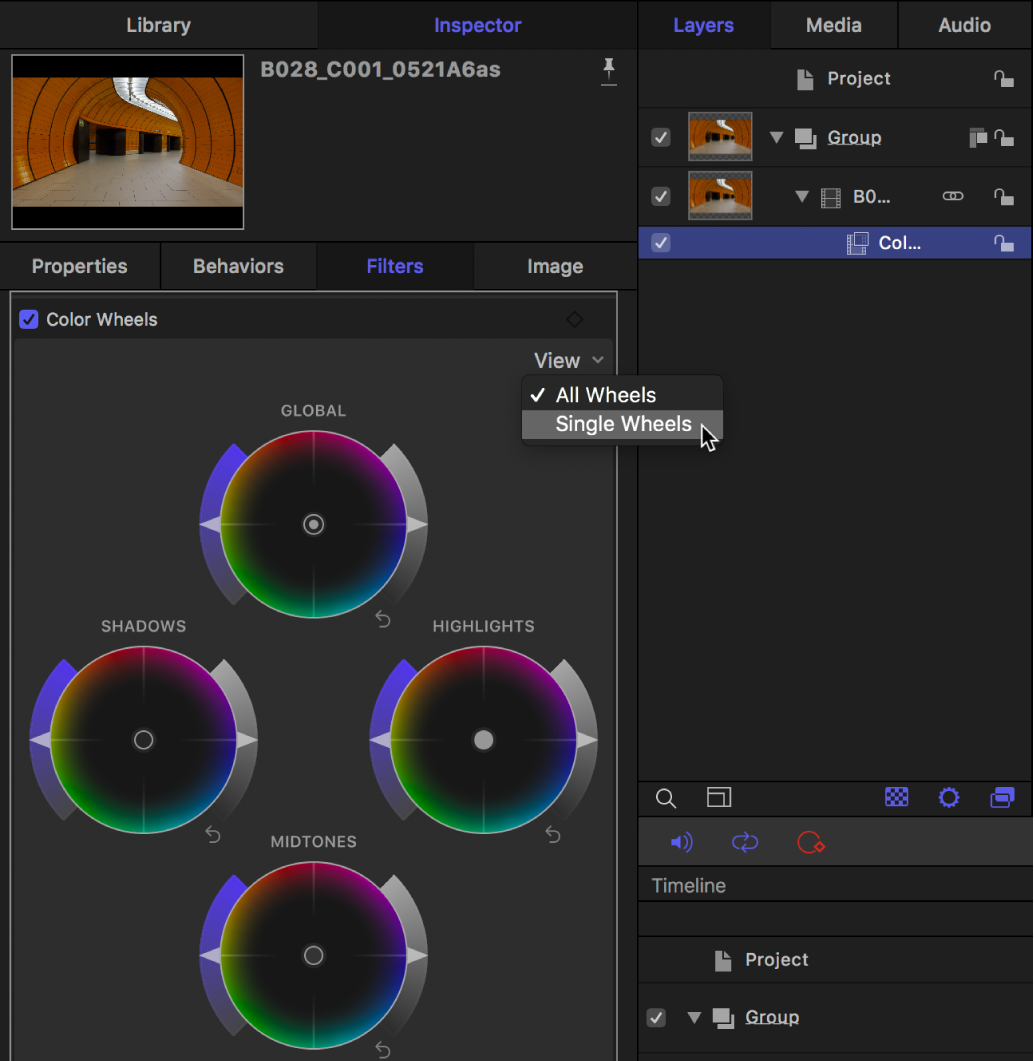
Single Wheels: Displays one large color wheel at a time. In Single Wheels view, click a button above the curve to display a specific wheel.
The Global color wheel adjusts the entire tonal range of the image; the other color wheels adjust only the shadows, midtones, or highlights.
To change an image’s brightness, color, or saturation, adjust the controls for a color wheel in any of the tonal ranges:
Adjust the color value: Drag the color control in the center of a wheel.
You can also move the color control by selecting it, then pressing the Up Arrow, Down Arrow, Left Arrow, or Right Arrow key.
Adjust the saturation: Drag the Saturation slider on the left side of a wheel.
Adjust the brightness: Drag the Brightness slider on the right side of a wheel.
Note: You can also adjust color, saturation, and brightness values using the Global, Shadows, Midtones, and Highlights value sliders below the color wheels. Click the disclosure triangles to reveal these controls.
To make fine adjustments, press and hold the Option key as you drag a control in a color wheel.
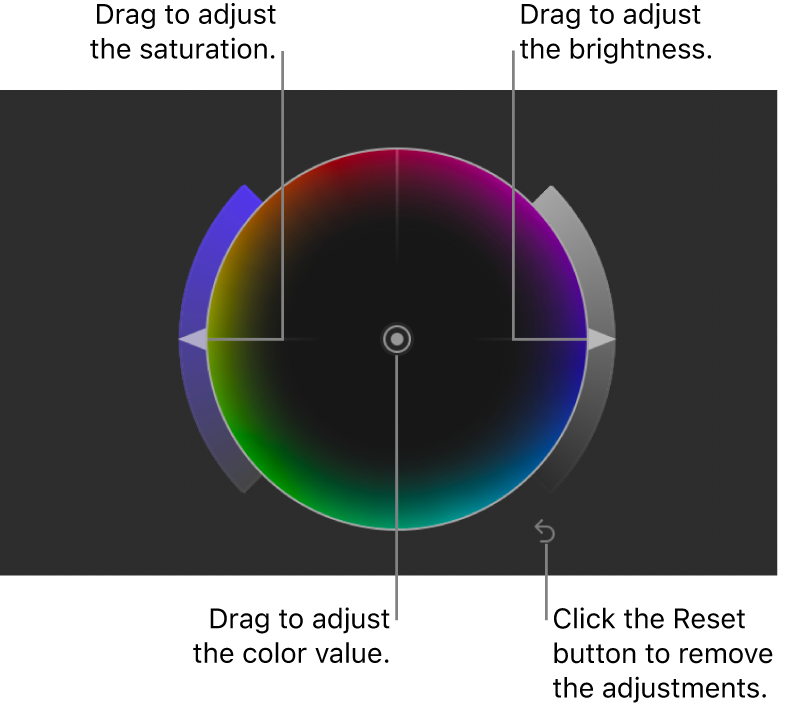
Use the controls under the color wheels to adjust any of the following:
Temperature: Adjust the color temperature, in degrees kelvin, so that the image looks as natural as possible. Color temperature describes the color value of light when the image was shot (not the light’s heat value). Drag the slider to the left to increase blue tones, or to the right to increase yellow-red tones. For example, if the image was shot under tungsten lights but the camera was set to daylight white balance, set the value between 2500 and 2900 degrees kelvin to white-balance the image.
Tint: Fine-tune the white-balance adjustment by neutralizing a remaining green or magenta tint. Drag the Tint slider to the left to add a green tint to the image, or to the right to add a magenta tint.
Hue: Use the Hue dial or value slider to set a value from 0° to 360°, effectively rotating all hues in the image around the perimeter of the color wheel. A value of 0° represents the original image.
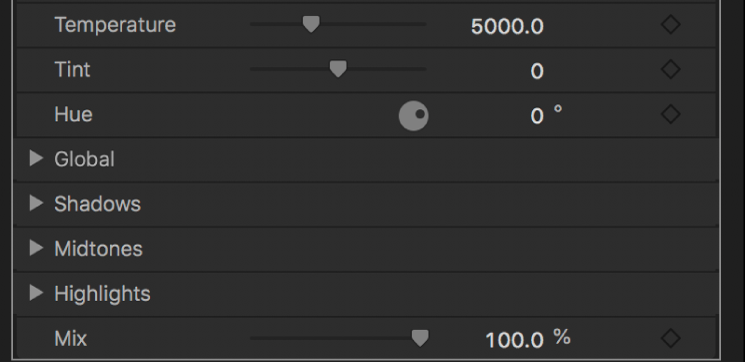
Mix: Adjust this slider to set the amount of the original image that’s blended with the color-corrected image.
To reset the values for a color wheel, click its Reset button. To reset the values for all color wheels and value sliders, click the down arrow (in the upper-right corner of the filter controls) to open the Animation pop-up menu, then choose Reset Parameter.
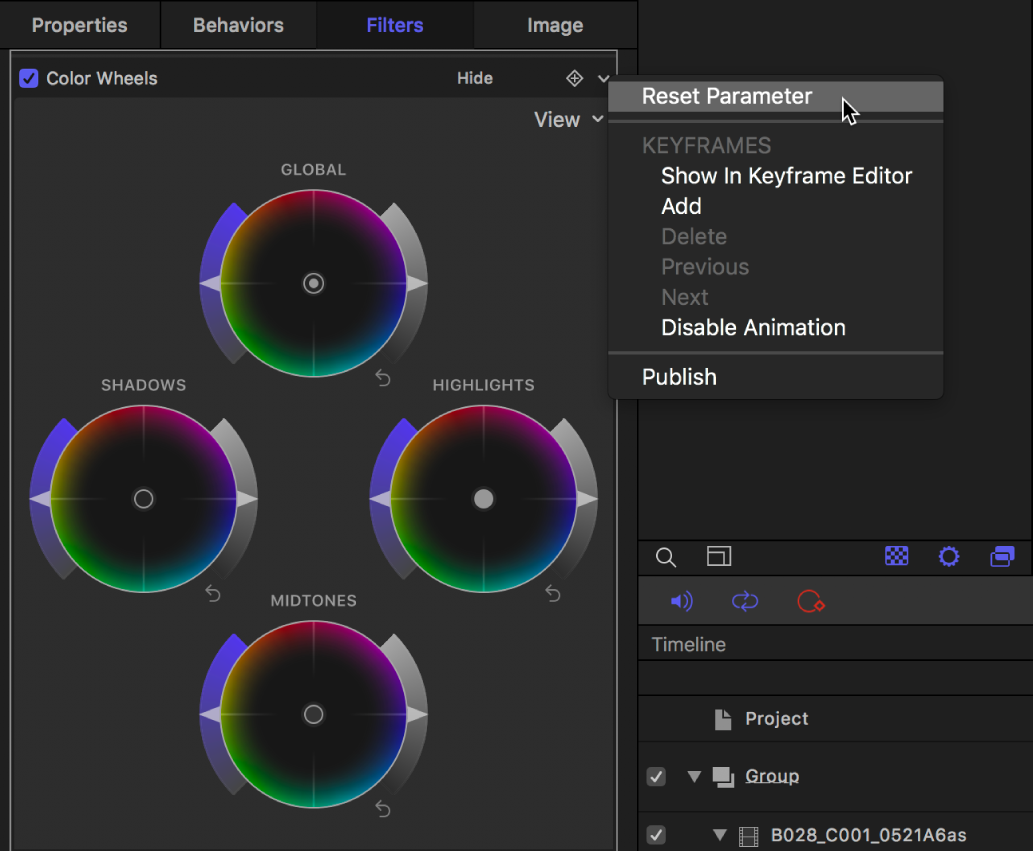
Note: You cannot publish the Color Wheels filter as a Final Cut Pro custom effects template.
Download this guide: PDF